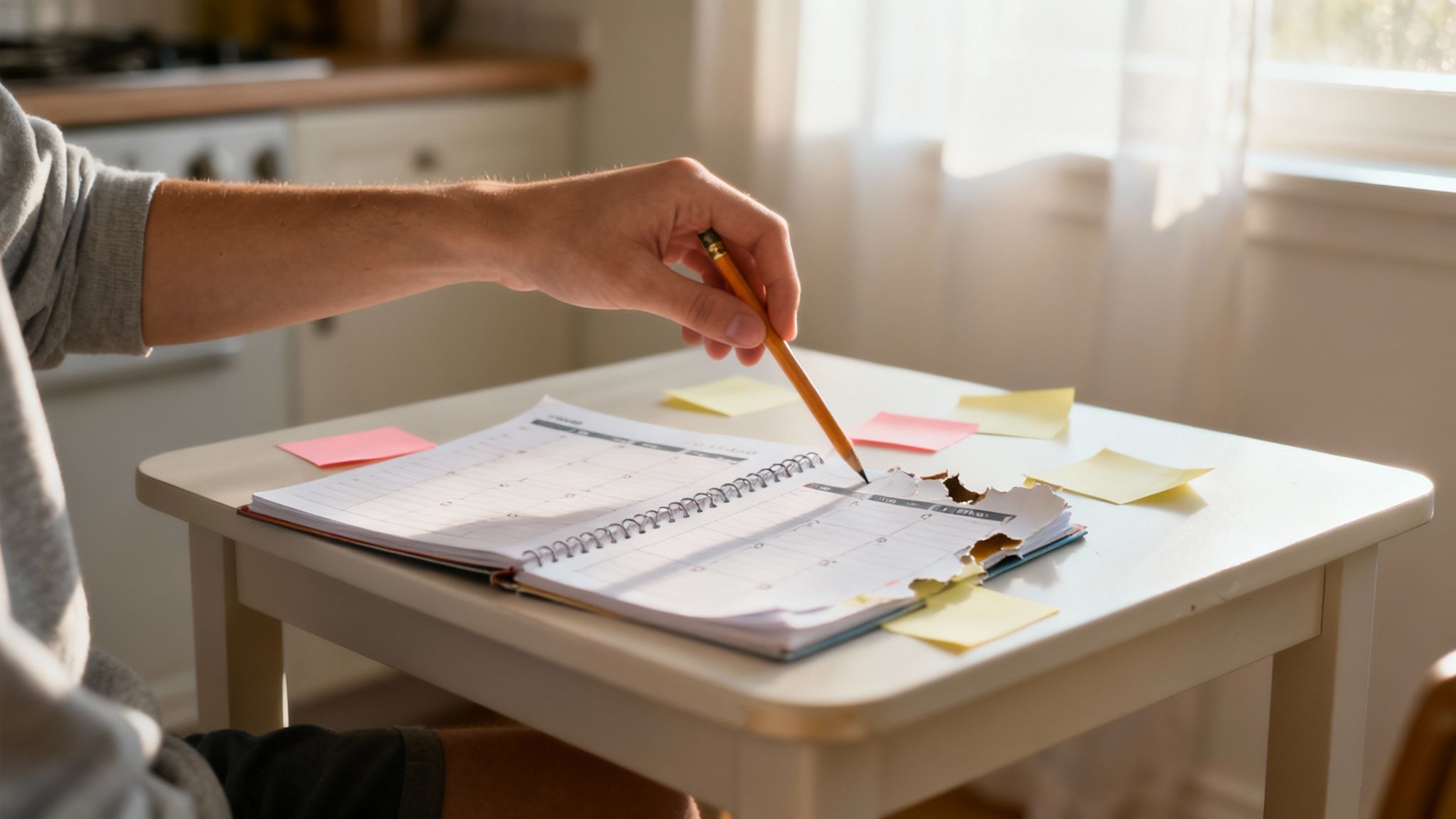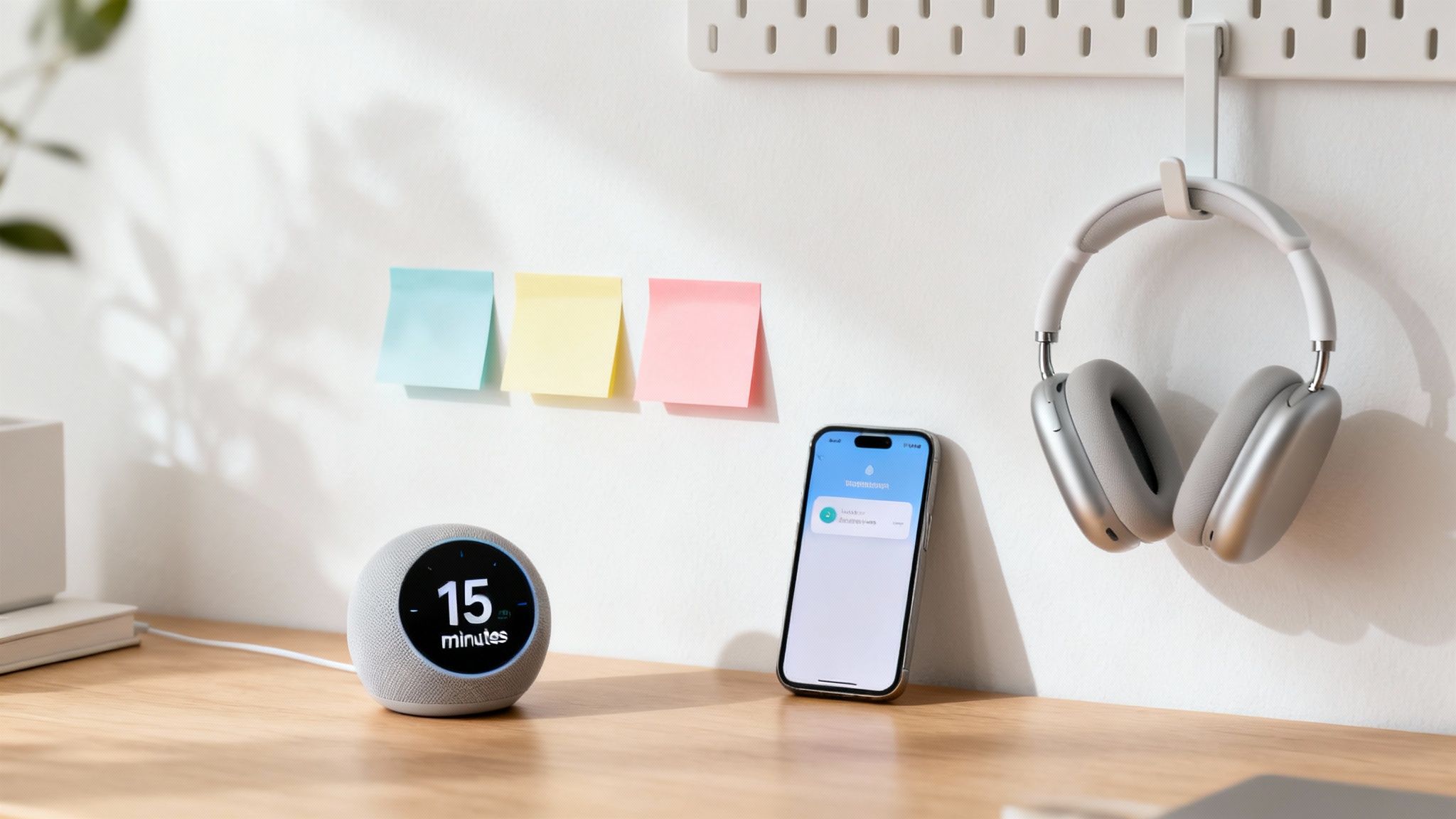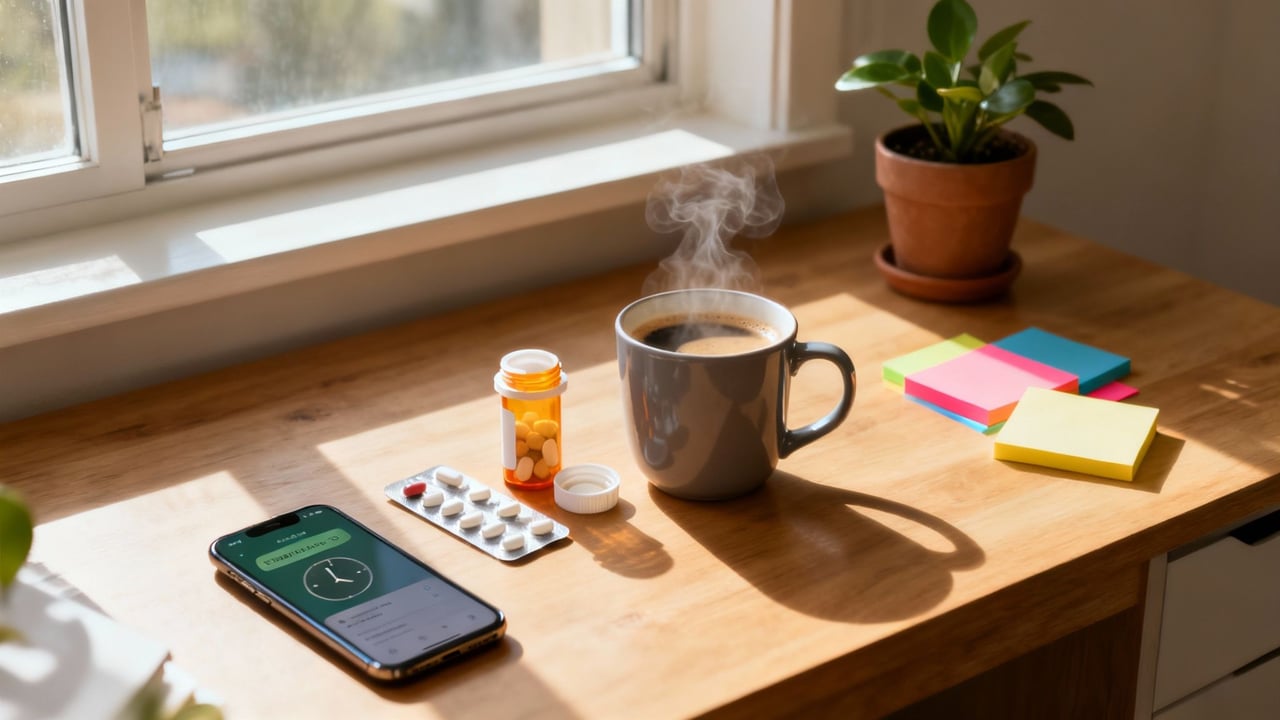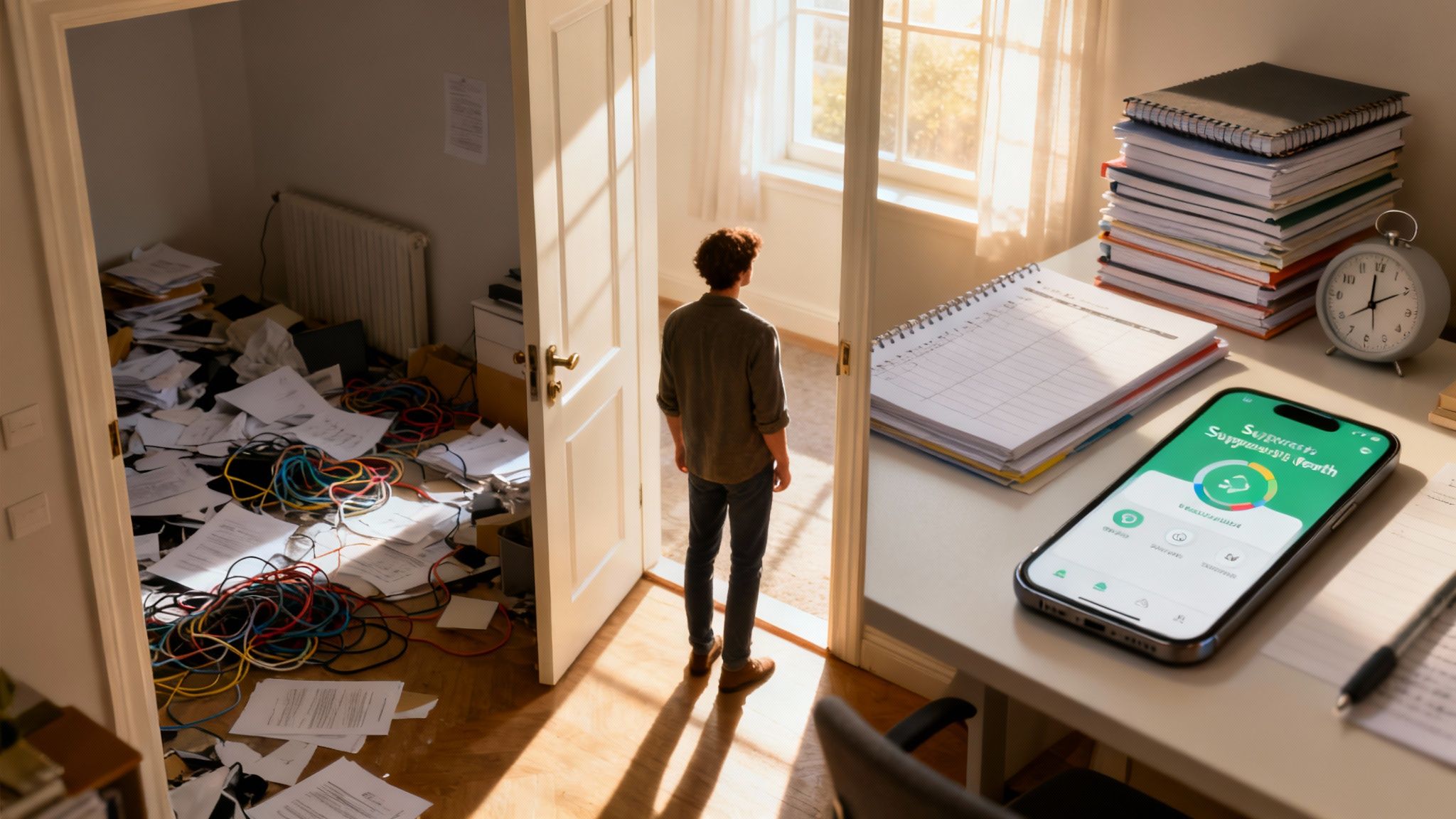If you have ADHD, the very idea of a “routine” might make you want to run for the hills. Trying to build and stick to one can feel like being stuck in a frustrating, never-ending cycle. Let's get one thing straight: this isn't a personal failing. It’s a neurological mismatch.
Traditional routines often fail because they aren't designed for the ADHD brain, which craves novelty and struggles with the very executive functions needed to maintain a rigid structure. The good news? You can build a system that works with your brain, not against it.
Why Routines Can Feel Impossible With ADHD

Does this sound painfully familiar? You map out the perfect daily schedule, jam-packed with productive habits and neatly organized time blocks. For a few days, maybe even a week, you feel on top of the world. Then, things start to slip. You miss one small step, then another, and before you know it, the whole system has collapsed, leaving you feeling defeated all over again.
This experience is incredibly common among people with ADHD. The problem isn't a lack of willpower or a desire for consistency. The real issue is that most routine-building advice is made for neurotypical brains—brains that don't have to fight the same internal battles with focus, motivation, and time perception.
The Neurodivergent Disconnect
For a brain that runs on dopamine and craves novelty, a rigid, repetitive schedule can feel like a punishment. What seems simple to others—like a consistent morning sequence—can demand a huge amount of mental energy from you. This is where the core challenges of ADHD crash the party.
Difficulties with executive functions are at the heart of this struggle. Think of these as your brain's management team, responsible for planning, organizing, starting tasks, and keeping emotions in check. When these skills aren't reliable, even the best-laid plans can fall apart. You might find it impossible to switch from one activity to another or simply forget what you were supposed to be doing next.
💡 The goal isn't to force yourself into a neurotypical mold. It's to build a flexible framework that supports your brain's unique wiring, providing structure without feeling like a cage.
A More Compassionate Approach
Instead of blaming yourself, it’s time for a major mindset shift. The key to making routines work with an ADHD brain is to stop fighting against it and start working with it. That means creating systems that are:
- Flexible: Your routine needs to have wiggle room for low-energy days and unexpected changes.
- Visually Cued: Out of sight is out of mind. External reminders are your best friends.
- Dopamine-Friendly: Build in small rewards and bits of novelty to keep your brain engaged and interested.
- Simple: Start with one tiny new habit, not a complete life overhaul.
This guide will walk you through actionable, brain-based strategies to help you finally build routines that actually stick. Programs like the Inflow app are specifically designed around these principles, offering bite-sized lessons and tools to help you understand your brain and create systems that truly support you.
Ready to stop the cycle of shame and start building a life that works for you?
The Science of Why Your ADHD Brain Resists Structure
If you’ve ever felt like your brain is actively fighting the very structure you’re trying to build, you’re not imagining things. It's not a personal failing or a lack of willpower; it’s a matter of brain chemistry and wiring. Getting a handle on the why can be a massive step toward self-compassion and finding strategies that finally stick.
The daily battle with routines often boils down to a few key neurological factors that make following a predictable script incredibly challenging for the ADHD brain.
The Dopamine Dilemma
Deep down, the ADHD brain has a complicated relationship with dopamine, the neurotransmitter that handles motivation, reward, and focus. Many people with ADHD have lower levels of available dopamine, which basically means the brain is constantly on the hunt for activities that give it a quick, satisfying hit.
Mundane, repetitive tasks—the very backbone of most routines—offer almost zero dopamine. This isn't just about feeling "bored." To an ADHD brain, a low-dopamine activity can feel physically draining and nearly impossible to start. It’s the reason you can hyperfocus on a fascinating new project for hours but can’t bring yourself to consistently load the dishwasher every night.
💡 Your brain isn't just being difficult; it's desperately searching for the neurochemical stimulation it needs to function. This is exactly why building novelty and small rewards into your routines isn't just a nice idea—it's a non-negotiable strategy.
Living with Time Blindness
Another huge hurdle is something called time blindness. This is the persistent difficulty in sensing the passage of time, guessing how long a task will take, or feeling how much time is left. It’s a core executive function challenge that can completely sabotage any schedule you try to set.
You might genuinely believe you have "just five more minutes" before you need to head out, only to look at the clock and realize thirty minutes have evaporated. Or you might put off a 10-minute task because it feels like it’s going to take an entire hour. This disconnect turns simple transitions—like moving from your morning coffee to starting work—into major, stressful hurdles.
For a deeper look into the unique wiring of the ADHD mind, you can learn more about the science behind the ADHD brain in our detailed article.
The Working Memory Gap
Ever walk into a room and completely forget what you went in there for? It happens to everyone, but for those of us with ADHD, it’s a constant battle with our working memory.
Think of working memory as your brain's temporary sticky note, holding onto the information you need right now to get a task done.
🔬 A Simple Scenario
Imagine your morning routine is just three simple steps:
- Take medication.
- Brush teeth.
- Get dressed.
You manage to take your meds, but on the way to the bathroom, your phone buzzes. You glance at the notification, and just like that, the "brush teeth" step has vanished from your mental sticky note. A tiny distraction has derailed the entire sequence because your working memory couldn't hold onto the plan.
This is why externalizing your routine with visual aids, checklists, and alarms isn’t just helpful—it’s essential. These tools provide the scaffolding your working memory needs to stay on track. This challenge also has a huge impact on critical habits, like taking medication consistently. Research on ADHD treatment and medication adherence on hsc.wvu.edu shows that simpler medication plans paired with visual reminders can make a massive difference.
Ultimately, understanding these brain-based challenges completely reframes the conversation. You're not lazy or undisciplined for struggling with routines; you're managing a brain that's playing by a different set of rules.
Have you noticed these patterns in your own life? Just recognizing them is the first real step toward building a system that finally supports you.
How to Build Your ADHD-Friendly Routine Blueprint
Okay, we've covered the neurological reasons why routines can feel like climbing a mountain in flip-flops. Now we can get to the good part: the 'how.' Building a routine isn't about trying to cram your wonderfully unique ADHD brain into a neurotypical box. It's about designing a supportive blueprint that actually works with your brain's wiring.
That means we're ditching perfectionism. The goal here is a flexible, compassionate, and brain-friendly approach. The secret is to start ridiculously small and make things almost laughably easy. Forget the idea of a massive life overhaul overnight. We're aiming for tiny, achievable wins that give your brain the dopamine hit it craves to keep moving forward.
Start with Micro-Habits
A micro-habit is a behavior so small it feels silly not to do it. The entire point is to lower the barrier to entry so much that your executive functions don't even have a chance to protest. It’s all about sidestepping that familiar feeling of overwhelm that leads straight to procrastination.
So, instead of a goal like "clean the kitchen," your micro-habit becomes "put one dish in the dishwasher." "Organize the office" turns into "put one piece of paper in the recycling bin."
These tiny actions might feel insignificant, but they're powerful. They drastically reduce the mental energy needed for task initiation—often the biggest hurdle for an ADHD brain. Each time you complete one, you get a little buzz of accomplishment, building the positive feedback loop you need to maybe add another small habit later on.
Use Habit Stacking for Natural Flow
One of the most effective ways to build a new habit is to latch it onto something you already do without thinking. This is called habit stacking. You’re basically piggybacking a new, desired behavior onto an existing, automatic one.
The formula couldn't be simpler: After [Current Habit], I will [New Habit].
💡 Habit Stacking in Action:
- After I pour my morning coffee, I will take my medication.
- After I brush my teeth at night, I will lay out my clothes for tomorrow.
- After I finish dinner, I will wipe down one kitchen counter.
This trick is a game-changer because it eliminates the need to remember a new task out of the blue. Your existing habit becomes the natural, built-in reminder, which helps bridge the gap created by working memory challenges.
Externalize Everything with Cues
For the ADHD brain, "out of sight, out of mind" isn't just a saying; it's a law of physics. Trying to rely on mental reminders is setting yourself up to fail. The solution is to externalize your cues by placing physical, visual, or auditory prompts in your environment to trigger the next action.
💡 Think of your environment as an extension of your brain. By setting up external cues, you're outsourcing the job of remembering, freeing up precious mental energy for the task itself.
✅ Examples of External Cues:
- Place your medication bottle right next to your coffee maker.
- Put your gym bag directly in front of the door.
- Set a recurring phone alarm named "Start Shutdown Routine."
- Leave a sticky note on the bathroom mirror reminding you to floss.
These cues create a direct, unmissable link between your environment and what you want to do next. It makes your routine feel much more automatic and way less like a constant mental chore.
A big piece of the puzzle is implementing solid time management strategies to make these abstract concepts feel more concrete and manageable. The key is to see your routine not as a rigid set of rules but as an ongoing experiment. What works this week might need a tweak next week, and that’s perfectly okay. The real goal is consistency, not perfection.
Essential Tools and Tech for Daily Structure

Because the ADHD brain often struggles to create its own internal structure, one of the most powerful things you can do is build a reliable external one. Think of these tools and tech less like crutches and more like scaffolding for your executive functions. They're there to hold your routine together when your working memory or motivation decides to take a coffee break.
The real trick is moving past generic advice and finding things that actually click with how your brain works. This isn't about adding more digital chaos to your life. It's about strategically picking supports that make your day feel less like an uphill battle.
Making Time Tangible
A huge hurdle for any routine when you have ADHD is time blindness. If you can't really feel time passing, sticking to a schedule is next to impossible. This is where visual and auditory tools are absolute game-changers.
💡 Visual Timers: An abstract number on a screen doesn't mean much, but a visual timer shows time physically disappearing. Watching that red disk shrink makes "25 minutes" feel real, which is amazing for time-blocking or just getting through transitions. A simple free online countdown timer can be a great place to start experimenting.
💡 Smart Home Devices: Put your smart speakers to work for you. Just saying, "Hey Google, set a reminder for 5 PM called 'Start Shutdown Routine'" creates an auditory cue you can't ignore. It externalizes that nagging voice in your head, which frees up so much mental energy.
Digital Support Without the Overwhelm
The app store is a sea of productivity tools, and diving in can get overwhelming fast. The goal here is to find one or two systems that stick, not to download every shiny new thing you see.
Look for apps that were actually designed with the ADHD brain in mind. They often have features like gamification, super simple interfaces, and customizable reminders. For many of us, managing daily tasks is a huge part of managing symptoms, especially when treatment adherence is a challenge.
The Inflow app, for example, bakes task management and reminders right into its science-backed learning modules. This creates one cohesive system, so you're not just being told what to do, but you're also learning why it helps.
Your ADHD-Friendly Toolkit
Figuring out the right combination of tools is a personal journey of trial and error. What's a lifesaver for one person might be useless clutter for another, so give yourself permission to experiment without judgment.
💡 Remember, these tools aren't meant to "fix" you. They are designed to support you. You can't fail your tools; if a tool isn't working, it's the wrong tool for the job—not a reflection on you.
Here are a few ideas to get you started:
✅ Noise-Canceling Headphones: Absolutely essential for blocking out distractions. They create a "bubble" of focus when you just need to get something done.
✅ A Color-Coding System: Use different colored pens, sticky notes, or folders to visually separate tasks or priorities. It makes information so much easier to process at a glance.
✅ Body Doubling Apps or Videos: Sometimes, just the presence of another person (even a virtual one) is enough to get you started on a task. "Study with me" videos on YouTube can provide that gentle accountability.
✅ A Physical Whiteboard or Planner: Don't sleep on analog! Having your main priorities or weekly schedule physically visible in your space is a constant, passive reminder that your phone just can't replicate.
Have you noticed a particular type of tool—visual, auditory, or physical—that seems to work best for you? Leaning into that preference is the first step to building a toolkit that truly supports your daily structure.
Troubleshooting Common Routine Roadblocks
So you’ve done the work. You designed a flexible, dopamine-friendly routine that actually feels good. Things are clicking along, you're feeling on top of things, and then... well, life happens.
You get sick. A surprise deadline lands on your desk and blows up your week. Or maybe you just wake up and your motivation tank is completely empty for no reason at all. Suddenly, the whole system grinds to a halt.
If this is the point where you usually start spiraling into shame and just give up, stop right there. A good routine isn't a fragile glass sculpture that shatters at the first bump. Think of it more like a bonsai tree—it's meant to be pruned, shaped, and adapted over time.
Falling off track isn’t a personal failure. It's just a data point showing you where your system needs a little more wiggle room.
The Inevitable 'Off' Day (or Week)
First, let's get one thing straight: one bad day doesn't erase all your progress. It’s incredibly easy for the ADHD brain to slip into that all-or-nothing thinking trap, but the real goal here is consistency over time, not a perfect, unbroken streak.
The second you realize you've fallen off the wagon, the most critical step is to practice some self-compassion. Instead of beating yourself up, get curious.
Ask yourself, "Okay, what was the actual roadblock here?" Was it a sudden drop in energy? An unexpected interruption? Or just plain old boredom setting in?
This isn’t about making excuses—it’s about practical problem-solving. When you identify the "why," you can see the issue as an external puzzle to solve, not some internal character flaw. Then, just restart with the smallest possible action. Don't try to force yourself back into your full routine. Just do one tiny thing. That small win is all you need to break the inertia.
Adapting for Low-Energy Days
Let’s be real. Some days, you're just not going to have the executive function reserves to tackle your "ideal" routine, and that is completely okay. Trying to force yourself to push through on fumes is just a fast track to burnout.
What you need is a backup plan: a 'minimum viable day.'
💡 Your minimum viable day is the absolute bare-bones version of your routine. It’s a short list of 2-3 non-negotiable tasks that, if you get them done, will keep you stable and prevent things from completely derailing.
What might a minimum viable day look like?
- Take my medication.
- Brush my teeth.
- Eat at least one real meal.
That’s it. On your worst days, everything else is a bonus. Having this pre-defined, super-simple plan gives you a clear, achievable target when you feel completely overwhelmed.
How to Combat Routine-Killing Boredom
The ADHD brain is a novelty-seeking machine. After a few weeks of the same old, same old, that initial dopamine rush from your new routine starts to fade. Boredom creeps in, and your once-helpful structure can start to feel like a restrictive cage.
When this happens, it's a clear signal that it's time to shake things up. Don't scrap the whole system—just inject a little novelty.
✅ Introduce a 'Menu of Options': Instead of one rigid task, create a small menu of choices. For your "afternoon movement" block, your menu could be a 10-minute walk, a 5-minute dance party, or a quick stretching session. This gives your brain the choice it craves while keeping the core routine intact.
✅ Schedule a 'Routine Reset': Be proactive. Intentionally plan to review and tweak your routine every few weeks. This turns routine maintenance into an engaging project, satisfying that need for newness before boredom has a chance to fully set in.
If you find yourself constantly hitting these roadblocks, it might be a sign that you need more structured support. The learning modules in the Inflow app are designed to help you build these exact problem-solving skills, turning frustrating roadblocks into opportunities for growth.
Answering Your Questions About ADHD and Routines
Diving into the world of ADHD and routines always kicks up a lot of questions. It’s so easy to feel like you're the only one hitting these specific walls.
Let's tackle some of the most common questions we hear. The answers all circle back to the same core ideas: being flexible, showing yourself some compassion, and finding strategies that work with your brain, not against it.
How can I stick to a routine when I get bored so easily?
Ah, the classic ADHD challenge. This is your brain's relentless search for dopamine in action. Once a routine gets too predictable, the novelty—and your motivation—vanishes. The trick isn't to force yourself through the boredom, but to build novelty right into your day.
Instead of a rigid schedule, think of it like creating a "menu" of options for certain parts of your day.
Maybe your non-negotiables stay the same (like taking meds). But for your "movement" slot, you could choose between a walk, a quick yoga video, or a five-minute dance party to your favorite song. Just having that small element of choice can be enough to satisfy your brain's need for something new.
What is the single most important first step to creating a routine?
Without a doubt, the most crucial first step is to identify your biggest pain point and pick one tiny 'keystone habit' to fix it. The number one mistake people make is trying to overhaul their entire life overnight. That path almost always leads straight to overwhelm and burnout.
Instead, start small. So small it feels almost silly not to do it.
Is your morning a frantic, stressful mess? Your first and only step could be laying out your clothes the night before. Is your evening a chaotic disaster zone? Your first step might be to put just one dish in the dishwasher right after dinner.
💡 This tiny win does more than just check a box; it builds momentum and self-trust. It gives you a small dopamine hit that proves you can do this, making it so much easier to stack another small habit on top of it later.
My family doesn't have ADHD and cannot understand why this is so hard. How do I explain it?
Getting neurotypical loved ones to understand can be tough, but framing it from a brain-based perspective can build a bridge. Try to steer the conversation away from willpower and focus on the actual neurology.
You could try saying something like this: "For my ADHD brain, starting a task or remembering all the steps isn't about wanting to do it. It's a wiring issue with my brain's management system—things called executive functions—and a chemical called dopamine. Routines that feel automatic to you take a massive amount of mental energy and focus for me."
Analogies can also be incredibly helpful for bridging that understanding gap.
💡 Try this analogy: "Imagine trying to run a race with ankle weights on. That's what building and sticking to a routine can feel like. The timers, checklists, and alarms I use are like my support tools; they're essential things that help me do something my brain isn't naturally wired to do easily."
This simple shift can change the conversation from one about your character to one about your neurology and the support you need.
Can a program like Inflow actually help me build routines?
Absolutely. A science-based program like Inflow is built specifically to help you understand the "why" behind your ADHD struggles while giving you a structured, supportive path to build the skills you need.
The app gives you daily, bite-sized learning modules that break down complex topics like executive functions and time blindness into easy-to-digest pieces. It pairs that education with practical tools like habit-trackers, smart reminders, and an entire community of people who really, truly get it.
It’s this combination of external structure and compassionate guidance that’s often the missing piece for those of us with ADHD. It helps you turn that knowledge into real, lasting habits that actually stick.







